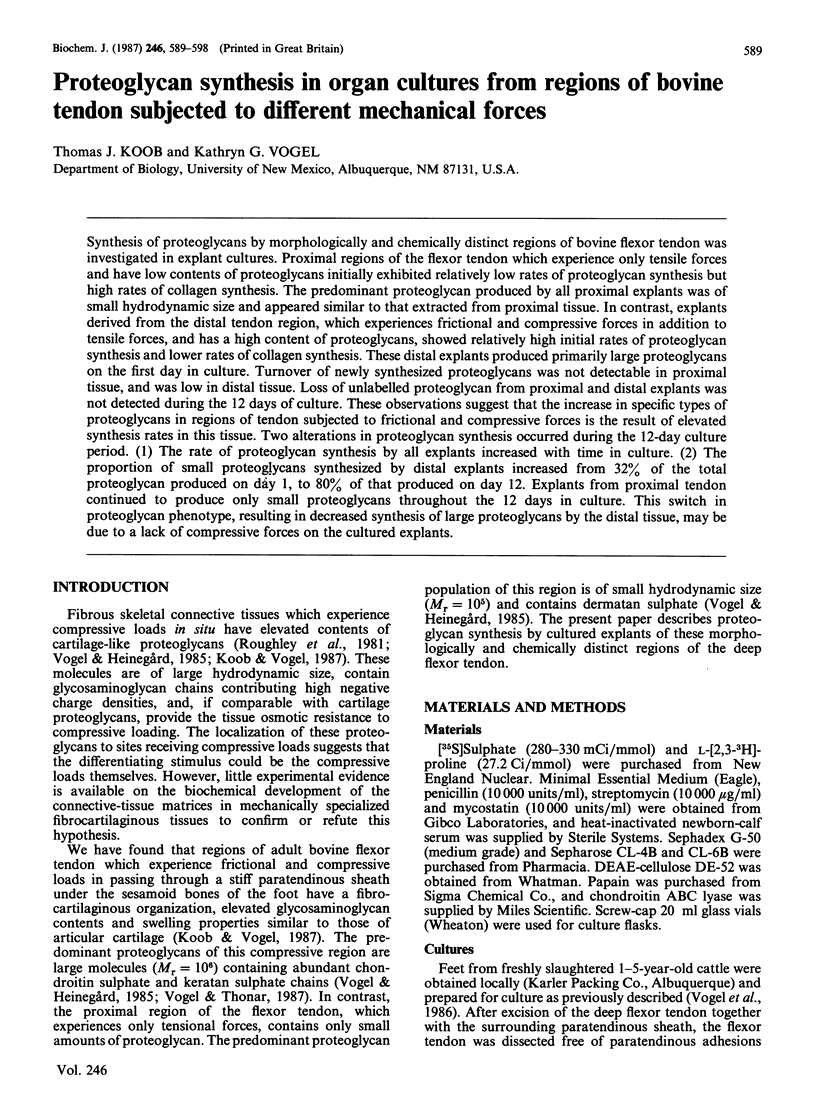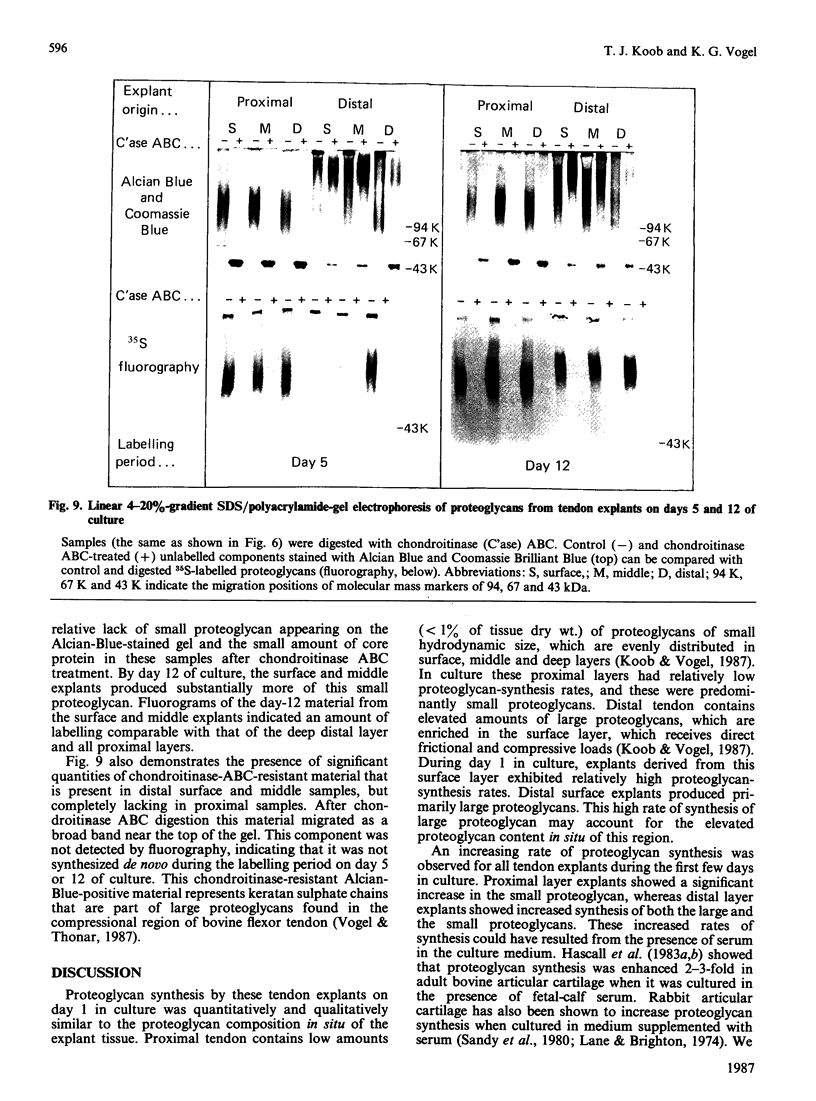Abstract
Synthesis of proteoglycans by morphologically and chemically distinct regions of bovine flexor tendon was investigated in explant cultures. Proximal regions of the flexor tendon which experience only tensile forces and have low contents of proteoglycans initially exhibited relatively low rates of proteoglycan synthesis but high rates of collagen synthesis. The predominant proteoglycan produced by all proximal explants was of small hydrodynamic size and appeared similar to that extracted from proximal tissue. In contrast, explants derived from the distal tendon region, which experiences frictional and compressive forces in addition to tensile forces, and has a high content of proteoglycans, showed relatively high initial rates of proteoglycan synthesis and lower rates of collagen synthesis. These distal explants produced primarily large proteoglycans on the first day in culture. Turnover of newly synthesized proteoglycans was not detectable in proximal tissue, and was low in distal tissue. Loss of unlabelled proteoglycan from proximal and distal explants was not detected during the 12 days of culture. These observations suggest that the increase in specific types of proteoglycans in regions of tendon subjected to frictional and compressive forces is the result of elevated synthesis rates in this tissue. Two alterations in proteoglycan synthesis occurred during the 12-day culture period. (1) The rate of proteoglycan synthesis by all explants increased with time in culture. (2) The proportion of small proteoglycans synthesized by distal explants increased from 32% of the total proteoglycan produced on day 1, to 80% of that produced on day 12. Explants from proximal tendon continued to produce only small proteoglycans throughout the 12 days in culture. This switch in proteoglycan phenotype, resulting in decreased synthesis of large proteoglycans by the distal tissue, may be due to a lack of compressive forces on the cultured explants.
Full text
PDF









Images in this article
Selected References
These references are in PubMed. This may not be the complete list of references from this article.
- Campbell M. A., Handley C. J., Hascall V. C., Campbell R. A., Lowther D. A. Turnover of proteoglycans in cultures of bovine articular cartilage. Arch Biochem Biophys. 1984 Oct;234(1):275–289. doi: 10.1016/0003-9861(84)90350-3. [DOI] [PubMed] [Google Scholar]
- Fisher L. W., Termine J. D., Dejter S. W., Jr, Whitson S. W., Yanagishita M., Kimura J. H., Hascall V. C., Kleinman H. K., Hassell J. R., Nilsson B. Proteoglycans of developing bone. J Biol Chem. 1983 May 25;258(10):6588–6594. [PubMed] [Google Scholar]
- Gillard G. C., Reilly H. C., Bell-Booth P. G., Flint M. H. The influence of mechanical forces on the glycosaminoglycan content of the rabbit flexor digitorum profundus tendon. Connect Tissue Res. 1979;7(1):37–46. doi: 10.3109/03008207909152351. [DOI] [PubMed] [Google Scholar]
- Hascall V. C., Handley C. J., McQuillan D. J., Hascall G. K., Robinson H. C., Lowther D. A. The effect of serum on biosynthesis of proteoglycans by bovine articular cartilage in culture. Arch Biochem Biophys. 1983 Jul 1;224(1):206–223. doi: 10.1016/0003-9861(83)90205-9. [DOI] [PubMed] [Google Scholar]
- Hascall V. C., Morales T. I., Hascall G. K., Handley C. J., McQuillan D. J. Biosynthesis and turnover of proteoglycans in organ culture of bovine articular cartilage. J Rheumatol Suppl. 1983 Dec;11:45–52. [PubMed] [Google Scholar]
- Heinegård D., Wieslander J., Sheehan J., Paulsson M., Sommarin Y. Separation and characterization of two populations of aggregating proteoglycans from cartilage. Biochem J. 1985 Jan 1;225(1):95–106. doi: 10.1042/bj2250095. [DOI] [PMC free article] [PubMed] [Google Scholar]
- Koob T. J., Vogel K. G. Site-related variations in glycosaminoglycan content and swelling properties of bovine flexor tendon. J Orthop Res. 1987;5(3):414–424. doi: 10.1002/jor.1100050314. [DOI] [PubMed] [Google Scholar]
- Lane J. M., Brighton C. T. In vitro rabbit articular cartilage organ model. I. Morphology and glycosaminoglycan metabolism. Arthritis Rheum. 1974 May-Jun;17(3):235–243. doi: 10.1002/art.1780170306. [DOI] [PubMed] [Google Scholar]
- Manske P. R., Lesker P. A. Biochemical evidence of flexor tendon participation in the repair process--an in vitro study. J Hand Surg Br. 1984 Jun;9(2):117–120. [PubMed] [Google Scholar]
- Roughley P. J., McNicol D., Santer V., Buckwalter J. The presence of a cartilage-like proteoglycan in the adult human meniscus. Biochem J. 1981 Jul 1;197(1):77–83. doi: 10.1042/bj1970077. [DOI] [PMC free article] [PubMed] [Google Scholar]
- Sandy J. D., Brown H. L., Lowther D. A. Control of proteoglycan synthesis. Studies on the activation of synthesis observed during culture of articular cartilages. Biochem J. 1980 Apr 15;188(1):119–130. doi: 10.1042/bj1880119. [DOI] [PMC free article] [PubMed] [Google Scholar]
- Slack C., Flint M. H., Thompson B. M. The effect of tensional load on isolated embryonic chick tendons in organ culture. Connect Tissue Res. 1984;12(3-4):229–247. doi: 10.3109/03008208409013685. [DOI] [PubMed] [Google Scholar]
- Vogel K. G., Heinegård D. Characterization of proteoglycans from adult bovine tendon. J Biol Chem. 1985 Aug 5;260(16):9298–9306. [PubMed] [Google Scholar]
- Vogel K. G., Keller E. J., Lenhoff R. J., Campbell K., Koob T. J. Proteoglycan synthesis by fibroblast cultures initiated from regions of adult bovine tendon subjected to different mechanical forces. Eur J Cell Biol. 1986 Jun;41(1):102–112. [PubMed] [Google Scholar]



